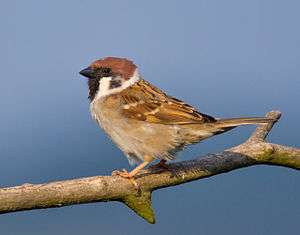Four Pests Campaign

The Great Sparrow Campaign (Chinese: 打麻雀运动; pinyin: Dǎ Máquè Yùndòng), also known as the Kill a Sparrow Campaign (Chinese: 消灭麻雀运动; pinyin: Xiāomiè Máquè Yùndòng) and, officially, as the Four Pests Campaign, was one of the first actions taken in the Great Leap Forward in China from 1958 to 1962. The four pests to be eliminated were rats, flies, mosquitoes, and sparrows.[1] The systematic extermination of sparrows led to an upset of the ecological balance, and enabled crop-eating insects to proliferate.
Campaign
The campaign against the "Four Pests" was initiated in 1958 as a hygiene campaign by Mao Zedong, who identified the need to exterminate mosquitoes, flies, rats, and sparrows. Sparrows – mainly the Eurasian tree sparrow[1][2] – were included on the list because they ate grain seeds, robbing the people of the fruits of their labour. The masses of China were mobilized to eradicate the birds, and citizens took to banging pots and pans or beating drums to scare the birds from landing, forcing them to fly until they fell from the sky in exhaustion. Sparrow nests were torn down, eggs were broken, and nestlings were killed.[1][3] Sparrows and other birds were shot down from the sky, resulting in the near-extinction of the birds in China.[4] Non-material rewards and recognition were offered to schools, work units and government agencies in accordance with the volume of pests they had killed.
Some sparrows found refuge in the extraterritorial premises of various diplomatic missions in China. The personnel of the Polish embassy in Beijing denied the Chinese request of entering the premises of the embassy to scare away the sparrows who were hiding there and as a result the embassy was surrounded by people with drums. The Chinese claimed the drums were to contain the sparrows, who would be too afraid of the sound to leave the embassy. After two days of constant drumming, the Poles had to use shovels to clear the embassy of dead sparrows. [5]
By April 1960, Chinese leaders realized that sparrows ate a large amount of insects, as well as grains.[3][2] Rather than being increased, rice yields after the campaign were substantially decreased.[1][2] Mao ordered the end of the campaign against sparrows, replacing them with bed bugs in the ongoing campaign against the Four Pests.[3] By this time, however, it was too late. With no sparrows to eat them, locust populations ballooned, swarming the country and compounding the ecological problems already caused by the Great Leap Forward, including widespread deforestation and misuse of poisons and pesticides.[1] Ecological imbalance is credited with exacerbating the Great Chinese Famine, in which 20–45 million people died of starvation.[6][7]
Revived campaign
On June 19, 1998, a poster was spotted at Southwest Agricultural University in Chongqing, "Get rid of the Four Pests". Ninety-five percent of households were ordered to get rid of four pests. This time, sparrows were replaced with cockroaches.[3] A similar campaign was spotted in the spring of 1998 in Beijing. Few people responded to these campaigns, as they were already fond of killing the aforementioned pests, especially cockroaches.[3]
Cultural influence
In the TVB drama series Rosy Business (aired 2009 but set in mid-1800s China), a peasant came up with the idea of killing the sparrows to improve agricultural output. It was meant to be a prank used to trick the peasant owners into starvation and poverty.
In Episode 20 of the children's animated television series Sagwa, the Chinese Siamese Cat (aired 2001–2002 but set in China around 1900), the mistress of the house declares that certain useless animals are banned from the compound. After the animals – the episode's eponymous birds, bees, and silkworms – are driven out, the family discovers the consequences. The mistress' fancy banquet is ruined by the lack of food and clothing, and she learns a valuable lesson.
The album Every Red Heart Shines Toward the Red Sun (2006) by the American post-rock band Red Sparowes tells, by way of its song titles, the story of the Great Sparrow Campaign.
The children's book Sparrow Girl (2009) by Sara Pennypacker tells the story of the Sparrow War.
See also
References
- 1 2 3 4 5 Summers-Smith, J. Denis (1992). In Search of Sparrows. London: Poyser. pp. 122–124. ISBN 0-85661-073-9.
- 1 2 3 McCarthy, Michael (2 August 2006). "The secret life of sparrows". The Independent. Retrieved 30 January 2009.
- 1 2 3 4 5 Shapiro, Judith Rae (2001). Mao's War Against Nature: Politics and the Environment in Revolutionary China. Cambridge University Press. ISBN 0-521-78680-0.
- ↑ Dikotter, Frank (2010). Mao's Great Famine. New York: Walker & Co. p. 188.
- ↑ "Chiny. Historia" [China. History] (in Polish). 2 June 1999. Retrieved 3 May 2016.
- ↑ Peng, Xizhe (1987). "Demographic Consequences of the Great Leap Forward in China's Provinces". Population and Development Review. 13 (4): 639–670. doi:10.2307/1973026.
- ↑ Akbar, Arifa (17 September 2010). "Mao's Great Leap Forward 'killed 45 million in four years'". The Independent.
External links
- PBS series "The Peoples' Century – 1949: The Great Leap"
- China follows Mao with mass cull (BBC)